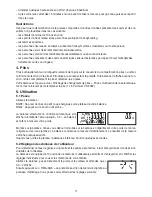
14
Attention:
Please do not confuse bone mass with bone density. Bone density can be determined only by
means of a medical examination (e.g. computer tomography, ultrasound). It is therefore not possible to draw
conclusions concerning changes to the bones and bone hardness (e.g. osteoporosis) using this scale.
Little influence can be exerted on bone mass, but it will vary slightly within the influencing factors (weight,
height, age, gender).
AMR
The active metabolic rate (AMR) is the amount of energy required daily by the body in its active state. The
energy consumption of a human being rises with increasing physical activity and is measured on the dia-
gnostic scale in relation to the degree of activity entered (1– 5).
To maintain your existing weight, the amount of energy used must be reintroduced into the body in the form
of food and drink. If less energy is introduced than is used over a longer period of time, your body will ob-
tain the difference largely from the amount of fat stored and your weight will reduce. If, on the other hand,
over a longer period of time more energy is introduced than the total active metabolic rate (AMR) calcula-
ted, your body will be unable to burn off the excess energy, and the excess will be stored in the body as fat
and your weight will increase.
Results in relation to time
Note that it is only the long-term trend which counts. Short period fluctuations in weight over a few days are
mostly the result of a loss of fluid.
The interpretation of the results will depend on changes in your: overall weight and body fat, body water and
muscle percentages, as well as on the period during which these changes take place. Rapid changes within
days must be distinguished from medium term changes (over weeks) and long term changes (months).
A basic rule is that short term changes in weight almost exclusively represent changes in water content, whe-
reas medium and long term changes may also involve the fat and muscle percentages.
• If your weight reduces over the short term, but your body fat percentage increases or remains the same,
you have merely lost water – e.g. after a training session, sauna session or a diet restricted only to rapid
weight loss.
• If your weight increases over the medium term and the body fat percentage falls or stays the same, then
you could have built up valuable muscle mass.
If your weight and body fat percentage fall simultaneously then your diet is working – you are losing fat mass.
Ideally you should support your diet with physical activity, fitness or power training. By this means, you can
increase your muscle percentage over the medium term.
Possible causes of errors:
– The maximum load-bearing capacity of
150 kg (330 lbs) was exceeded.
– The electrical resistance between the electrodes
and the soles of your feed is too high
(e.g. with heavily callused skin).
– Your body fat lies outside the measurable range
(less than 3 % or greater than 55 %).
– Your percentage of water lies outside the
measurable range (less than 25 % or greater
than 75 %)
Remedy:
– Only weigh the maximum permissible weight.
– Repeat weighing barefoot.
Slightly moisten the soles of your feet if necessary.
Remove the calluses on the soles of your feet if
necessary.
– Repeat weighing barefoot.
– Slightly moisten the soles of your feet if necessary.
– Repeat weighing barefoot.
– Slightly moisten the soles of your feet if necessary.















































